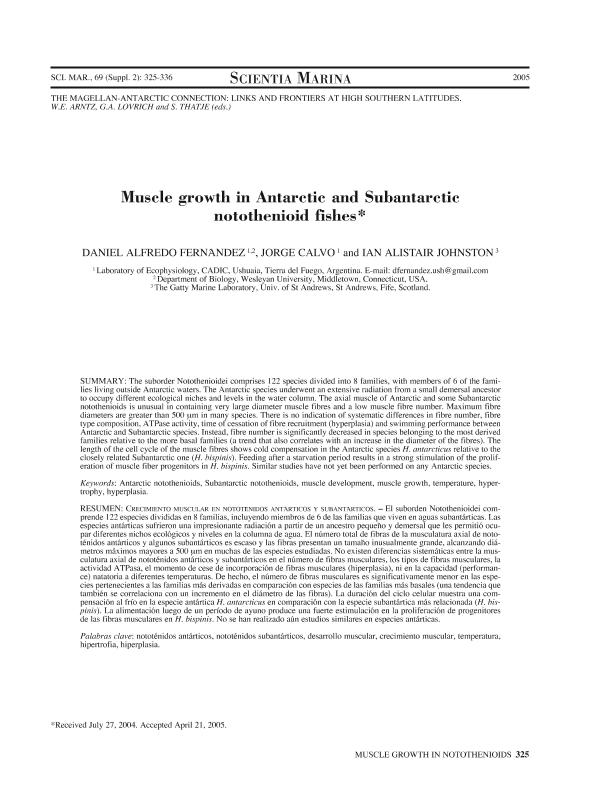Mostrar el registro sencillo del ítem
dc.contributor.author
Fernández, Damián Andrés

dc.contributor.author
Calvo, Jorge

dc.contributor.author
Johnston, Ian Alistair
dc.date.available
2022-07-14T13:24:09Z
dc.date.issued
2005-12
dc.identifier.citation
Fernández, Damián Andrés; Calvo, Jorge; Johnston, Ian Alistair; Muscle growth in Antarctic and Subantarctic notothenioid fishes; Instituto de Ciencias del Mar Barcelona; Scientia Marina; 69; 12-2005; 325-336
dc.identifier.issn
0214-8358
dc.identifier.uri
http://hdl.handle.net/11336/162110
dc.description.abstract
The suborder Notothenioidei comprises 122 species divided into 8 families, with members of 6 of the families living outside Antarctic waters. The Antarctic species underwent an extensive radiation from a small demersal ancestor to occupy different ecological niches and levels in the water column. The axial muscle of Antarctic and some Subantarctic notothenioids is unusual in containing very large diameter muscle fibres and a low muscle fibre number. Maximum fibre diameters are greater than 500 μm in many species. There is no indication of systematic differences in fibre number, fibre type composition, ATPase activity, time of cessation of fibre recruitment (hyperplasia) and swimming performance between Antarctic and Subantarctic species. Instead, fibre number is significantly decreased in species belonging to the most derived families relative to the more basal families (a trend that also correlates with an increase in the diameter of the fibres). The length of the cell cycle of the muscle fibres shows cold compensation in the Antarctic species H. antarcticus relative to the closely related Subantarctic one (H. bispinis). Feeding after a starvation period results in a strong stimulation of the proliferation of muscle fiber progenitors in H. bispinis. Similar studies have not yet been performed on any Antarctic species.
dc.format
application/pdf
dc.language.iso
eng
dc.publisher
Instituto de Ciencias del Mar Barcelona

dc.rights
info:eu-repo/semantics/openAccess
dc.rights.uri
https://creativecommons.org/licenses/by/2.5/ar/
dc.subject
ANTARCTIC NOTOTHENIOIDS
dc.subject
HYPERPLASIA
dc.subject
HYPERTROPHY
dc.subject
MUSCLE DEVELOPMENT
dc.subject
MUSCLE GROWTH
dc.subject
SUBANTARCTIC NOTOTHENIOIDS
dc.subject
TEMPERATURE
dc.subject.classification
Zoología, Ornitología, Entomología, Etología

dc.subject.classification
Ciencias Biológicas

dc.subject.classification
CIENCIAS NATURALES Y EXACTAS

dc.title
Muscle growth in Antarctic and Subantarctic notothenioid fishes
dc.type
info:eu-repo/semantics/article
dc.type
info:ar-repo/semantics/artículo
dc.type
info:eu-repo/semantics/publishedVersion
dc.date.updated
2022-07-04T19:21:14Z
dc.identifier.eissn
1886-8134
dc.journal.volume
69
dc.journal.pagination
325-336
dc.journal.pais
España

dc.description.fil
Fil: Fernández, Damián Andrés. Consejo Nacional de Investigaciones Científicas y Técnicas. Centro Austral de Investigaciones Científicas; Argentina. Ohio Wesleyan University.; Estados Unidos
dc.description.fil
Fil: Calvo, Jorge. Consejo Nacional de Investigaciones Científicas y Técnicas. Centro Austral de Investigaciones Científicas; Argentina
dc.description.fil
Fil: Johnston, Ian Alistair. University of St. Andrews; Reino Unido
dc.journal.title
Scientia Marina

dc.relation.alternativeid
info:eu-repo/semantics/altIdentifier/doi/https://doi.org/10.3989/scimar.2005.69s2325
dc.relation.alternativeid
info:eu-repo/semantics/altIdentifier/url/https://scientiamarina.revistas.csic.es/index.php/scientiamarina/article/view/334
Archivos asociados
